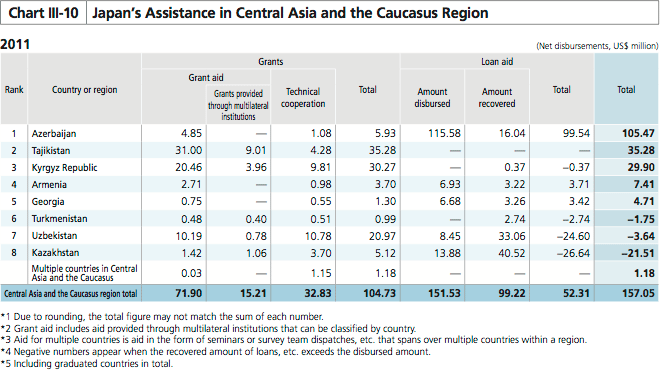Japan's Official Development Assistance White Paper 2012
3. Central Asia and the Caucasus
Central Asia and Caucasus regions are politically and geographically important areas that are surrounded by Russia, China, South Asia, the Middle East, and Europe. The regions are also strategically important to Japan, with their large abundance of energy and mineral resources such as oil, natural gas, uranium, rare metals, etc. The stability and development of these regions impact on the Eurasia region as a whole including Japan. From this perspective, Japan provides support for nation-building to establish long-term stability and sustainable development in the regions, taking into consideration a broad regional perspective which covers Afghanistan, Pakistan, and other regions that border Central Asia. These efforts are intended to establish a universal system of values, including human rights, democracy, market economy, and the rule of law.
<Japan's Efforts>
In order to facilitate the transition from a planned economy to a market economy and achieve economic development, Japan has conducted a diverse range of assistance activities, such as establishment of legal systems, rebuilding of health and medical care and other aspects of social development, improvement of the infrastructure for economic development, and the human resources development for the transition to a market economy. For example, Japan Centers* in Uzbekistan, Kazakhstan, and the Kyrgyz Republic contribute to the human resources development that can respond to the transition to a market economy by providing business courses and other activities based on Japan’s experiences. (See this for details)
Some of the world–class oil fields are found in the Caspian Sea coast of Kazakhstan and Azerbaijan. Japanese companies also own their interests. The stability and economic development of the region are important for stabilizing the international energy market as well as for securing energy resources. Japan provides assistance to the region, including support for the improvement of public services, human resources, and infrastructure like power plants.
In addition, Japan established a framework of the "Central Asia plus Japan" Dialogue in 2004 focusing on the promotion of intra-regional cooperation, and has conducted dialogue including foreign ministers' meeting and cooperation at a variety of levels. The fourth such foreign ministers' meeting was held in Tokyo in November 2012, commemorating 20th anniversary of the establishment of diplomatic relations between Japan and Central Asian countries.
- *The Japan Center
- There are nine Japan Centers in eight countries which aim to achieve transition to market economies. They serve as a venue to facilitate personal contacts between Japan and these countries and as a base for Japan's assistance for developing human resources in the business sector through sending experts and providing training in business management and other skills. They are a fine example of the Visibility of Japanese aid.
●Tajikistan
Project for the Rehabilitation of Kurgan Tyube-Dusti Road (Phase 2)
Grant Aid (December 2011 - Present)
Roads are the main transportation infrastructure in landlocked Tajikistan, but the country's road network was built 30 to 40 years ago under the former Soviet Union and continues to deteriorate. Many zones have suffered damage because of the civil war, and that damage inhibits economic activity. To resolve this problem, Japan, recognizing the improvement of transportation infrastructure as a main area of support for Tajikistan, has worked with the Asian Development Bank (ADB) in improving roads that run from the capital of Dushanbe to the border with Afghanistan.
The aim of this project is to improve a section of the Kurgan Tyube-Dusti road, which Japan has been helping upgrade. After completion of the Project, drivers will be able to drive safely at 73 km/h rather than the current 30 km/h (except for urban zones). In the future, this road will pass through the Afghanistan capital of Kabul to Karachi, the largest city in Pakistan, giving Tajikistan access to the Indian Ocean. This cooperation will facilitate the distribution of goods throughout the region and is expected to contribute to the economic development of Tajikistan.
(As of December 2012)

Construction work on the road from Kurgan Tyube to Dusti (Photo: JICA)


